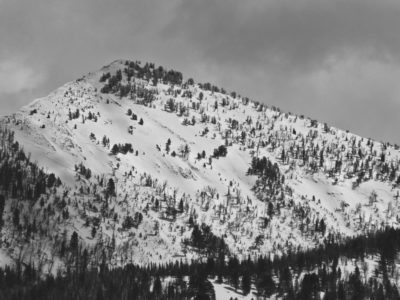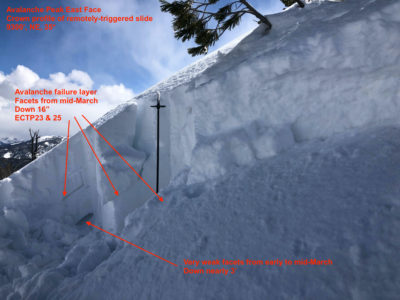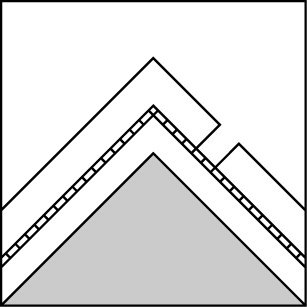Basic Information
Observation Details
Observation Date:
April 2, 2020Submitted:
April 2, 2020Observer:
SAC - LundyZone or Region:
Galena Summit and Eastern MtnsLocation:
Avalanche PeakSigns of Unstable Snow
Recent Avalanches?
YesCracking?
None ExperiencedCollapsing?
None ExperiencedSnow Stability
Stability Rating:
FairConfidence in Rating:
ModerateStability Trend:
SteadyBottom Line
Investigated the remotely-triggered slide on the east face of Avalanche Peak. The slide released on a slope that faced from E to NE and broke 16 inches deep on a persistent weak layer of faceted snow that formed in mid-March. There is another persistent weak layer down nearly 3 feet that also looks concerning. Triggering a large persistent slab avalanche remains on the table on aspects facing E through N through NW.
Advanced Information
Weather Summary
Cloud Cover:
Mostly CloudyWind:
Light , NWEnough cloud cover and cold temps to prevent snow surface from getting too wet, but solars still have a surface crust. Settled storm snow from 3/29 storm was around 30cm.
Avalanche Observations
| # | Date | Location | Size | Type | Bed Sfc | Depth | Trigger | Comments | Photo |
|---|---|---|---|---|---|---|---|---|---|
| Several |
Behind Horton Peak W 9600 |
D2 | SS | Included these as nothing on the White Cloud side of the valley has been reported. Unsure of depth, trigger, etc. Didn't see any activity in the ~W facing paths on Horton proper. |

|
||||
| 1 |
Avalanche Peak East Face E 9300 |
D2 | SS | O-Old Snow | 40-50cm |
AS-Skier r-Remote |
This has been reported but adding measured depth and that it ran in an older persistent weak layer. | None |
Other observed slides had been reported or were very similar and fit the pattern of those that were.
Snowpack Observations
The avalanche was interesting in that the weak layer had a different configuration as you wrapped from the lookers right (E facing) to lookers left (NE facing). On the E facing side, it failed at the bottom of 5-7cm facet layer sandwiched between two crusts. On the NE facing side, there were no crusts and it was a 5cm layer of F facets below a 4F slab. I believe these weak layers both have the same date, although I'm having a tough time dating them—maybe 3/14 or 3/17?
I did a crown profile on the lookers L flank on a NE aspect. I had ECTP23 and 25 down 45cm on the layer described above.
On the NE aspect, there is a more prominent/thicker layer of larger grained F facets (3/7?) down 85cm that was likely responsible for the slides in Owl Creek and the Headwaters prior to the 3/29 storm. Scott also saw this in his ob from 3/31. I did not have time to perform tests on this layer, but it looked bad enough I didn't need to.
Both of these layers looked concerning and seem ripe for human-triggering.

Avalanche Problems
| Problem | Location | Distribution | Sensitivity | Size | Comments |
|---|---|---|---|---|---|
 Persistent Slab
Persistent Slab
|
|
Layer Depth/Date: early to mid March, 40-85cm Comments: Sensitivity is based on limited obs from today, likely reactive in spots |
